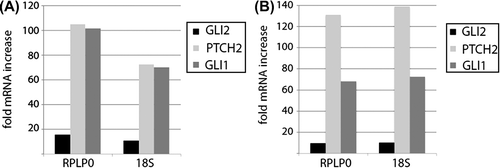Figures & data
Figure 1. Sodium [18F] fluoride PET (NAF PET) response. Four repeated NAF PET/CT scans in coronal view before (Figure 1A), and 2 weeks (Figure 1B), 2 months (Figure 1C) and 5 months (Figure 1D) after the start of vismodegib treatment. A generalized uptake of NAF is seen in Figure 1A. The intensity of uptake in the pelvic and hip bone has decreased in Figure 1B, and remains unchanged in Figure 1C. The uptake in the skeleton is still heterogeneous in Figure 1D, and has increased slightly.
![Figure 1. Sodium [18F] fluoride PET (NAF PET) response. Four repeated NAF PET/CT scans in coronal view before (Figure 1A), and 2 weeks (Figure 1B), 2 months (Figure 1C) and 5 months (Figure 1D) after the start of vismodegib treatment. A generalized uptake of NAF is seen in Figure 1A. The intensity of uptake in the pelvic and hip bone has decreased in Figure 1B, and remains unchanged in Figure 1C. The uptake in the skeleton is still heterogeneous in Figure 1D, and has increased slightly.](/cms/asset/d04cd912-b401-463a-a15e-12263795e39e/ionc_a_724537_f0001_b.jpg)
Figure 2. [18F]-fluorothymidine positron emission tomography (FLT PET) response. Four repeated FLT PET/CT scans in coronal view before (Figure 2A), and 2 weeks (Figure 2B), 2 months (Figure 2C) and 5 months (Figure 2D) after the start of vismodegib treatment. The uptake of FLT in the bone marrow is heterogeneous in Figure 2A. The spleen is enlarged and FLT uptake is intense. Figure 2B and C show a considerable reduction in FLT activity in bone marrow. The spleen is still enlarged with a high FLT uptake. A slight increase in the uptake can be seen in Figure 2D, heterogeneously distributed in the ribs, proximal humeri and femora. Uptake remains low in the spine. The sizes of the liver and spleen have decreased.
![Figure 2. [18F]-fluorothymidine positron emission tomography (FLT PET) response. Four repeated FLT PET/CT scans in coronal view before (Figure 2A), and 2 weeks (Figure 2B), 2 months (Figure 2C) and 5 months (Figure 2D) after the start of vismodegib treatment. The uptake of FLT in the bone marrow is heterogeneous in Figure 2A. The spleen is enlarged and FLT uptake is intense. Figure 2B and C show a considerable reduction in FLT activity in bone marrow. The spleen is still enlarged with a high FLT uptake. A slight increase in the uptake can be seen in Figure 2D, heterogeneously distributed in the ribs, proximal humeri and femora. Uptake remains low in the spine. The sizes of the liver and spleen have decreased.](/cms/asset/62543678-9e7d-48cd-9720-a0059d437655/ionc_a_724537_f0002_b.jpg)
Figure 3. Hedgehog signaling in the tumor compared to Daoy cells. Hedgehog (Hh) pathway activation in medulloblastoma tumor cells compared to activation in the Daoy cell line. The mRNA levels (assayed by real-time RT-PCR) of GLI1 and PTCH2 are strongly upregulated and the GLI2 mRNA level moderately upregulated, relative to the levels in the Daoy cell line. Shown are two biological replicates (Figure 3A and B) measured in technical triplicates, which were analyzed using the 2–ΔΔCT method using the housekeeping genes RPLP0 and 18S as references. Stdev (ct) ≤ 0.64.
